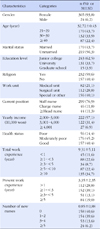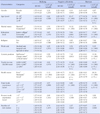Abstract
Purpose
The purpose of this study was to identify the effects of bullying, negative affectivity and burnout in the nurses.
Methods
The sample consisted of 389 nurses. Data were analyzed using frequency, percentage, mean, standard deviation, t-test, ANOVA, Scheffé, Pearson Correlation Analysis and Hierarchical Multiple Regression.
Results
The control variables of age, marital status, education level, current position, health status and work unit explained 30.2%(F=28.9, p<.001) of variance in burnout. The control variables, bullying and negative affectivity collectively explained 49.7% of variance in burnout.
Conclusion
The results indicate that the demographic factors influencing burnout are age, education level, health status, work unit, while bullying and negative affectivity in the work places are factors that influence burnout. These findings can be utilized to develop strategies to reduce bullying and negative affectivity.
Figures and Tables
References
1. Aiken LH, Clarke SP, Sloane DM, Sochalski J, Silber JH. Hospital nurse staffing and patient mortality, nurse burnout, and job dissatisfaction. JAMA. 2002; 288:1987–1993.
2. Alarcon G, Eschleman KJ, Bowling NA. Relationships between personality variables and burnout: A meta-analysis. Work Stress. 2009; 23:244–263. http://dx.doi.org/10.1080/02678370903282600.
3. Byun DS, Yom YH. Factors affecting the burnout of clinical nurses: Focused on emotional labor. J Korean Acad Nurs Adm. 2009; 15:444–454.
4. Cheung J. The decision process of leaving nursing. Aust Health Rev. 2004; 28:340–348.
5. Cho HY. Perfectionism tendency, social support and burnout among counselors. Seoul, Korea: Catholic University;2002. Unpublished master's thesis.
6. Choi HY. Concept analysis of burnout. Nurs Sci. 2010; 22(2):27–38.
7. Einarsen S, Hole H, Notelaers G. Measuring exposure to bullying and harassment at work: Validity factor structure and psychometric properties of the Negative Acts Questionnaire-Revised. Work Stress. 2009; 23(1):24–44. http://dx.doi.org/10.1080/02678370902815673.
8. Einarsen S, Hoel H, Zapf D. The concept of bullying and harassment at work: Developments in theory, research and practice. 2nd ed. Boca Raton, FL: CRC Press;2011.
9. Faul F, Erdfelder E, Lang AG, Buchner A. G*Power 3: A flexible statistical power analysis program for the social, behavioral, and biomedical sciences. Behav Res Methods. 2007; 39:175–191.
10. Glasø L, Notelaers G. Workplace bullying, emotions, and outcomes. Violence Vict. 2012; 27(3):360–377. http://dx.doi.org/10.1891/0886-6708.27.3.360.
11. Han KH. The moderating effects of negative affectivity on the relationships between the job characteristics andburnout outcomes. Daehan J Bus. 2007; 20:1475–1495.
12. June KJ, Byun SW. Nurse's burnout research throughout the past 10 years in Korea. J Korean Acad Nurs Adm. 2009; 5:305–313.
13. Karlson B, Jonsson P, Palsson B, Abjornsson G, Malmberg B, Larsson B, et al. Return to work after a workplace-oriented intervention for patient son sick-leave for burnout--a prospective controlled study. BMC Public Health. 2010; 10:301.
14. Ko JW, Seo YJ. Work rewards and occupational commitment of hospital nurses. Korean J Health Policy Adm. 2002; 12:77–98.
15. Laschinger HK, Grau AL, Finegan J, Wilk P. New graduate nurses' experiences of bullying and burnout in hospital settings. J Adv Nurs. 2010; 66:2732–2742. http://dx.doi.org/10.1111/j.1365-2648.2010.05420.x.
16. Leymann H. The content and development of mobbing at work. Eur J Work Organ Psychol. 1996; 5:165–184. http://dx.doi.org/10.1080/13594329608414853.
17. Lutgen-Sandvik P, Tracy SJ, Alberts JK. Burned by bullying in the American workplace: Prevalence, perception, degree and impact. J Manag Stud. 2007; 44:837–862. http://dx.doi.org/10.1111/j.1467-6486.2007.00715.x.
18. Maslach C, Jackson SE. The measurement of experienced burnout. J Organ Behav. 1981; 2:99–113. http://dx.doi.org/10.1002/job.4030020205.
19. Maslach C, Schaufeli W. Historical and conceptual development of burnout. Washington, DC: Taylor & Frances;1993.
20. Mckenna BG, Smith NA, Poole SJ, Coverdale JH. Horizontal violence: Experiences of registered nurses in their first year of practice. J Adv Nurs. 2003; 42(1):90–96.
21. Nam W. The relationship between workplace bullying and intention to leave among nurses in one university hospital. Seoul, Korea: Catholic University;2010. Unpublished master's thesis.
22. Nam W, Kim JW, Kim YK, Koo JW, Park CY. The reliability and validity of the Negative Acts Questionnaire-Revised (NAQ-R) for nurses for the assessment of workplace bullying. Korean J Occup Environ Med. 2010; 22:129–139.
23. Quine L. Workplace bullying in nursing profession. J Adv Nurs. 2001; 43(4):395–401.
24. Sá L, Fleming M. Bullying, burnout, and mental health amongst Portuguese nurses. Issues Ment Health Nurs. 2008; 29:411–426. http://dx.doi.org/10.1080/01612840801904480.
25. Simons S. Workplace bullying experienced by nurses newly licensed in Massachusetts and the relationship to intention to leave the organization. Boston: University of Massachusetts;2008. Unpublished dissertation.
26. Spooner-Lane R, Patton W. Determinants of burnout among public hospital nurses. Aust J Adv Nurs. 2007; 25(1):8–16.
27. Vahey DC, Aiken LH, Sloane DM, Clarke SP, Vargas D. Nurse burnout and patient satisfaction. Med Care. 2004; 42:II57–II66. http://dx.doi.org/10.1097/01.mlr.0000109126.50398.5a.
28. Watson D, Tellegen A. Toward a consensual structure of mood. Psychol Bull. 1985; 98:219–235.
29. Watson D, Clark L, Tellegen A. Development and validation of brief measures of positive and negative affect: The PANAS scales. J Pers Soc Psychol. 1988; 54:1063–1070.




 PDF
PDF ePub
ePub Citation
Citation Print
Print







 XML Download
XML Download